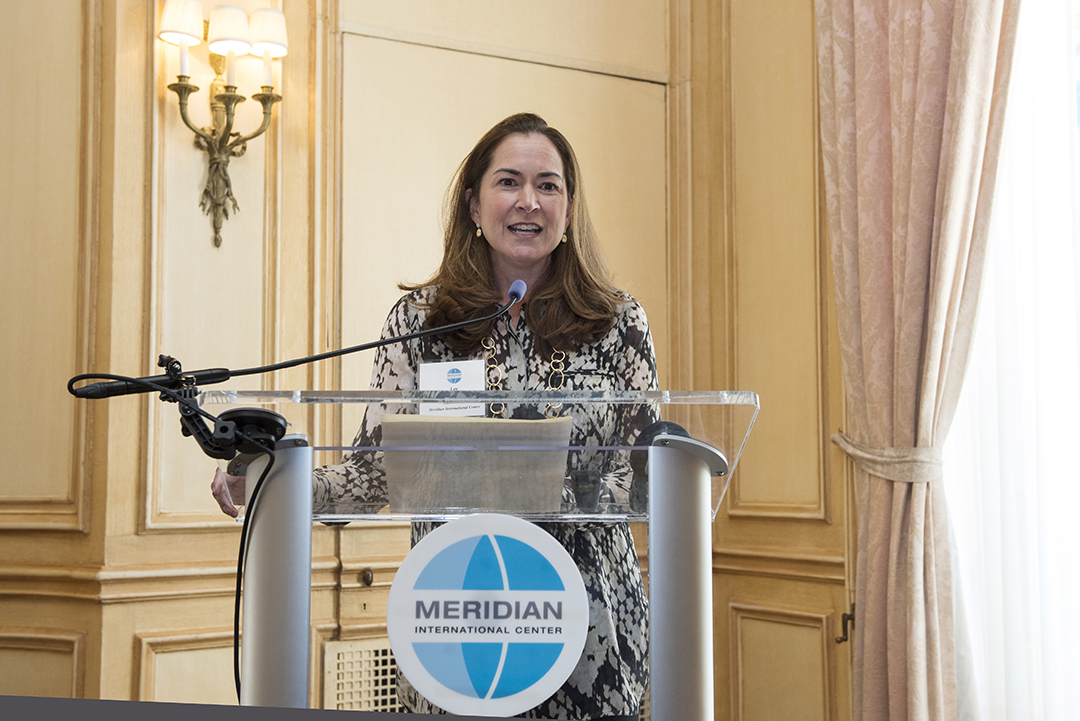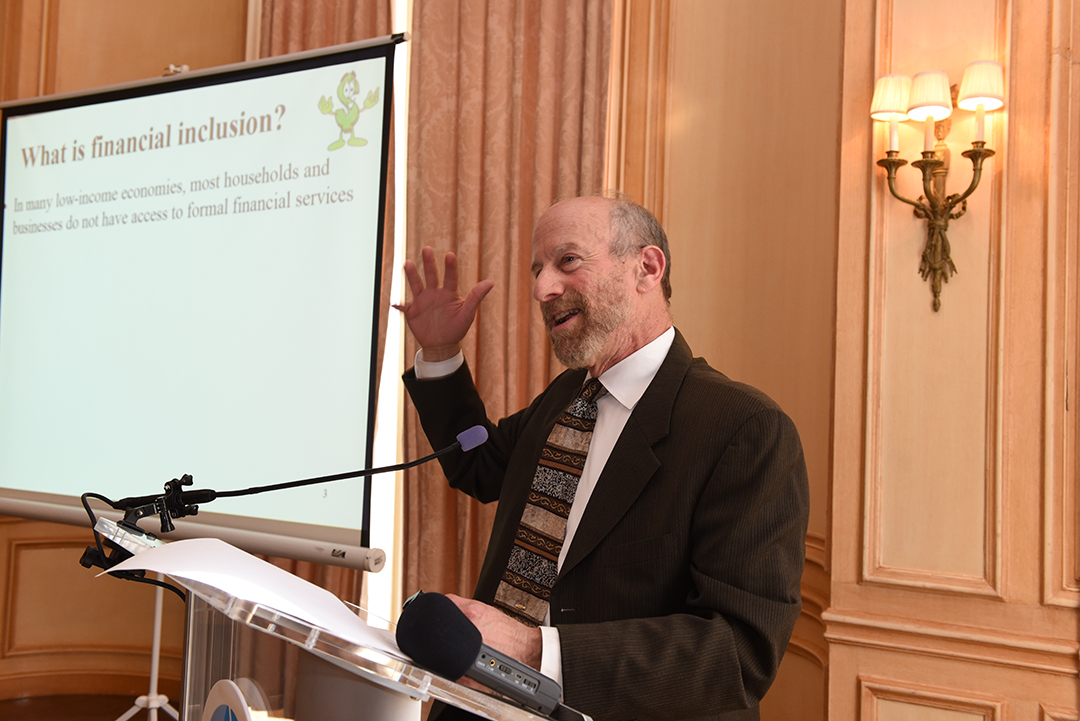Culture is Key to Changing Behaviors, Attitudes and Regulatory Environments in Digital Finance

The third regional session of The Digital Finance Future: Inclusive and Global Economic Growth series took place on March 9, 2017, gathering 30 individuals from the diplomatic corps, U.S. government, international development and policy organizations, academia and the private sector for a conversation on the role of regulations and technology, as well as behavioral biases and culture, in the digital drive for financial inclusion in East and Southeast Asia.
The session took place over two hours and was structured by two segments, each with three parts: the segments commenced with short speaker presentations, which framed simultaneous small-group discussions among attendees at their respective tables. The first presentation was led by Kyle Holloway, Financial Inclusion Program Manager at Innovations for Poverty Action, who outlined strategies for fostering healthy financial behaviors, particularly as developing nations fold into the digital economy. Leading the second presentation was Dr. Jay Rosengard, Director of the Mossavar-Rahmani Center for Business and Government's Financial Sector Program at Harvard Kennedy School, who unpacked the emerging role of RegTech – the intersection of technology and regulations – in digital finance. Both segments culminated with the full group reconvening to share key insights explored during the small-group conversations.
Trust in Finance

Participants discussed how foundational concerns, namely trust, precede behavioral biases around use of digital financial services. Representatives from policy and development organizations cited ethnographic research on varying levels of comfort among individuals who, for the first time, entrust their money and information to financial institutions. Oftentimes, cultural and social norms have a significant influence. In Pakistan, most women are not comfortable talking with male financial agents, primarily because of gender norms that give male heads of households the authority over accounts that women in their families may own. Moreover, skepticism around security of personal information also influences these women’s experiences with finance. Many women give out their mobile phone numbers or addresses when making financial transactions and, as an unintended but cultural consequence, they might receive unsolicited calls or visits from the male agents. In this regard, culture can inhibit the trust needed to overcome barriers to women’s financial inclusion.
While there are strategies to change the realities for women in Pakistan and help foster more trust in the finance sector, they are not universally applicable. One participant cited research about the effectiveness of female mobile money agents, who typically have higher sales and more transactions than their male counterparts. While this evidence alone is a compelling call for women to lead the mobile agent field, there is unfortunately reluctance among women in some cultures to even take up such a professional role – and the extra training and security protocol required are additional barriers.
Beyond these examples, participants noted that there is actually limited data on levels of trust in using financial technology. For this reason, many of the diplomats in the room offered examples of their respective countries’ legal mandates to foster trust in digital finance and encourage greater economic inclusion. In some nations, government employees are required to have bank accounts to receive their wages. In other cases, governments have developed policies to curb financial corruption. One diplomat offered an example of the old ‘five-six’ lenders who used to be the only accessible means to borrow money in rural areas: people would go to these lenders asking to borrow five units of currency and owe six by the end of the day. As the government outlawed these informal lenders and instead allowed for bank branches to operate in rural areas, more people began managing their money through the banks. This example showed how building trust is the first step in changing perceptions of and interactions with formal financial institutions. The next step is expanding this trust through digital mediation. Another participant highlighted the Mexican government’s mandate of all citizens using ATM cards to not only withdraw from their bank accounts but also transfer funds and receive subsidies. Twenty years since the policy, financial behaviors have normalized – demonstrating how repeated use of new tech-driven financial services can help build trust over time.
However, attitudes around government policies aimed at improving financial behavior typically vary across generations. Participants discussed how younger generations are more likely to adapt new technologies and explore their myriad applications, yet they do not want to be told what to do with their money. Governments that mandate a certain percentage of wages be directed toward a particular type of savings or withheld from a paycheck – even if the requirement has the consumer’s financial health at interest – can risk backlash and eradication of trust in their efforts to advance digital economic inclusion.
Cultural Context is Key to Improving Financial Health

Going hand in hand with building trust is understanding cultural context when encouraging new behaviors and attitudes around financial management. In Indonesia, there is no penalty for making a late payment on loans or credit charges. Rather, on-time payments are rewarded with a bonus. As such, financial institutions in Indonesia are first meeting citizens where they are in terms of existing financial habits and subsequently encouraging a natural shift toward better financial behavior through an incentive structure. With each behavioral change occurring at the individual level, Indonesia may see a natural societal shift toward better financial practices.
Another core takeaway was that cultural context matters when designing products and strategies for financial inclusion. Representatives from the nonprofit sector addressed the importance of embedding digital tools and resources for financial inclusion into existing cultural practices so that healthier financial behaviors emerge naturally and are sustained within the social fabric. In some societies, for example, a digital savings pool that anyone from the community can contribute to may be more effective and more desired than each individual having his or her own bank account and mobile phone.
Participants also discussed the necessity of understanding cultural context in order to avoid patronization, particularly when introducing new financial technologies. Many participants from development organizations and the business community referenced how most financial software and tools are typically built by people from Western/developed countries for customers around the world. However, the unique needs and desires of customers in developing countries and/or underprivileged communities are often neglected or not fully explored. One example offered was how tech leaders from Facebook to WhatsApp have rolled out their services to mobile phone users who do not in fact want or see a utility for those services. In digitally connected but not digitally socialized cultures, most people use their phones to check football scores that they then discuss in-person with their family and neighbors – rather than through mobile chat applications. This conversation reiterated the importance of understanding the desired uses of digital tools before designing them under unchecked assumptions.
Participants also explored the role of ethnographic entrepreneurship in financial inclusion. One discussant presented a domestic example to drive home this point: in rural Alabama, online banking is usually unsuccessful because people view the digitization of banking as a disruption to their social life. In fact, most rural Alabamans look forward to physically going to the bank and interacting with the local bank teller with whom they can exchange stories and catch up on their personal lives. On the flipside, another participant shared how some Asian banks have demonstrated ethnographic entrepreneurship by designing ‘level-zero’ accounts that allow typically disadvantaged people to build credit through alternative metrics, like mobile phone usage. The more financial institutions and FinTech entrepreneurs consider cultural context, the more relevant their services and products will be for, and thus more readily adopted by, the consumer.
Campaigning for Healthy Financial Behaviors

Given that cultural resistance and lack of trust in digital financial services still remain a challenge to advancing global economic inclusion, participants discussed the need for advocacy and public education campaigns alongside government policies. History has shown the effectiveness of such campaigns given that, time and again, people tend not to act in their own best interest – from not wearing helmets or seatbelts to texting while driving. Effective marketing campaigns that employ messaging like “click it or ticket” have helped to encourage healthy behaviors. As such, discussants presumed similar tactics could apply to digital finance.
One participant emphasized the importance of cultivating healthy financial behaviors at a young age, offering the piggy bank as one such mechanism to assist. This participant explained how some schools in developing nations have launched campaigns that promote good financial behavior by encouraging young children to put one coin per day into a piggy bank, which demonstrates how little things add up over time.
Another call for education among the participants surfaced while discussing how new financial technology can be ‘dangerous’ if the end users lack understanding of its applications and potential benefits. In the digital era, there are limitless opportunities for cross-sector collaboration in mobilizing resources and data in order to illustrate the potential outcomes and benefits of digital financial saving and management. Public-private partnerships in an education capacity not only amplify the advocacy messaging around digital financial behaviors but they also demonstrate the very transparency needed to build and retain public trust in the shift toward a digital-first future.
Defining RegTech

Before diving into the role of RegTech in the digital economy, participants first unpacked the term. Many expressed how there is a tendency to think about RegTech as a way to modify regulations to allow new players into the industry, namely tech companies or finance start-ups. But RegTech is actually the distinct technology designed to help enforce regulations – just like FinTech is technology for financial institutions. While these new technologies have emerged as tools to help regulators avoid and manage risk, many unknowns still remain around how RegTech can also propel innovation in the digital economy.
Participants discussed how most innovators want a rule book on digital finance regulations while regulators want to understand all possible outcomes before creating regulations, for fear of creating regulatory loopholes. Historically, regulators have seen FinTech entrepreneurs as a source of risk. Leaders of financial inclusion programs illuminated the possibility to change that relationship with RegTech: If regulators view the FinTech entrepreneur as someone who can help them improve their job of supervision, and if FinTech entrepreneurs see the regulator as a potential customer, new public-private partnerships could forge that naturally change the digital finance regulatory environment.
One example offered to demonstrate this success involved the Central Bank of the Philippines, which recently identified a need for FinTech to address consumer protection issues and for securing data sharing internally among bankers. When it comes to instances of fraud, corruption and money laundering, regulators are now able to use technologies to address and settle these issues in real-time. RegTech is also helping regulators ensure that consumer protection laws are not only in place and but also enforced, which is particularly important given all the skepticism around data security in the future digital economy. Through RegTech, financial institutions and regulators are better able to manage safety while simultaneously encouraging healthy competition and innovation in the digital finance market.
Digging in the Regulatory Sandbox

Despite the progress, participants expressed how dialogue is still needed to sort through some of the confusion around who is actually responsible for the regulation of digital finance. Some nations have developed regulatory ‘sandboxes,’ which are often symbolic of the conversation space for regulators and industry players to determine which regulations should be relaxed in order to advance the digital economy.
Participants cited the importance of these conversations, particularly in scenarios where multiple groups have a stake in the regulatory process. In Kenya, the communications authority offers guidance to the Central Bank. In Tanzania, the regulatory sandbox has helped bring together different players who oftentimes use technology to disentangle overlapping and conflicting regulations. In Singapore – the Asian FinTech capital – the banking system is fairly homogenous but regulatory sandboxes are helping relax strict rules and encourage an openness toward innovation.
In more developed nations like the United Kingdom, sandboxes are focused almost exclusively on innovation because the digital finance sector is already advanced. Most Western and developed countries are thinking about the digital single market and block chain, not necessarily how to get more women to adopt mobile technologies for financial transactions. A participant from the United States Congress reiterated the importance of innovation in the regulatory space, using the US Government’s outdated legislation as a prime example of how to easily run the risk of over-regulating in emerging fields like digital finance.
While regulatory sandboxes are helping to start cross-sector conversations around how to advance global financial inclusion through digital means, participants expressed the need for more data collection and information sharing across these sectors in order to create more transparency and change perceptions of regulations. A prime example of this need was cited by one participants who shared how big banks in Mexico are heavily regulated and, as such, have created subsidiaries that operate as finance companies to avoid certain types of regulation. Taking advantage of loopholes in regulatory systems is neither a sustainable nor healthy way to operate in the digital economy. But with the emergence of regulatory sandboxes, big banks and regulators alike now have a ‘safe space’ to share data and perform controlled experiments aimed at rejuvenating the health of regulatory environments like Mexico’s.
While most participants concluded that it is still too early to predict the influence of RegTech and ‘sandboxes’ in the future digital economy, they acknowledged that policy makers and central banks must continue working with private enterprises, nonprofits and grassroots communities to ensure that approaches to financial regulation are culturally relevant, country-specific and inclusive. Doing so will help strengthen trust and accountability in the global push toward the digital economy.
See More Photos
Project Partner
Participants
Project summary
| Culture is Key to Changing Behaviors, Attitudes and Regulatory Environments in Digital Finance | March 2017 | |
|---|---|
| Number of Attendees: | 34 |
| Regions: | South and Central Asia, East Asia and Pacific, Europe and Eurasia |
| Countries: | India, Pakistan, Philippines, Fiji, Singapore, Cambodia, Indonesia, China, Tanzania, Denmark |
| Impact Areas: | Governance and Transparency, Science and Technology |
| Program Areas: | Diplomatic Engagement |
| Partners: | NGOs |





